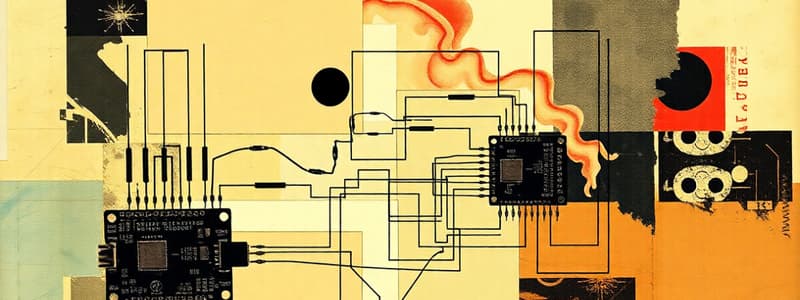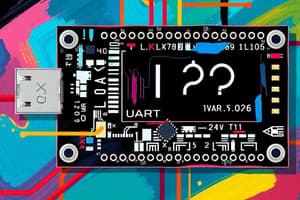Podcast
Questions and Answers
Explain the basic principles and importance of serial communication in embedded systems.
Explain the basic principles and importance of serial communication in embedded systems.
Serial communication is a method of data transmission where information is sent one bit at a time, sequentially, over a single communication channel.
Which of the following is a type of serial communication protocol?
Which of the following is a type of serial communication protocol?
- I2C (correct)
- Bus
- SATA
- Parallel
Identify and differentiate between various serial communication protocols.
Identify and differentiate between various serial communication protocols.
UART, SPI, and I2C are common serial communication protocols, each with unique characteristics and use cases.
What does UART stand for?
What does UART stand for?
What happens if you type A, B, or D in the serial communication?
What happens if you type A, B, or D in the serial communication?
What happens if you type C in the serial communication?
What happens if you type C in the serial communication?
Analyze and troubleshoot serial communication data using what types of software tools?
Analyze and troubleshoot serial communication data using what types of software tools?
Flashcards
Serial communication
Serial communication
A method of data transmission where information is sent one bit at a time, sequentially, over a single communication channel.
Communication protocol
Communication protocol
A set of standardized rules and conventions that define how data is exchanged between devices or systems within a network.
UART
UART
Easiest type of communication protocol and stands for Universal Asynchronous Transmitter Receiver.
Data from Microcontroller to PC
Data from Microcontroller to PC
Signup and view all the flashcards
Data from PC to Microcontroller
Data from PC to Microcontroller
Signup and view all the flashcards
Study Notes
Intended Learning Outcomes
- Explain the basic principles and importance of serial communication in embedded systems.
- Identify and differentiate between various serial communication protocols (e.g., UART, SPI, I2C) and their use cases.
- Configure and program serial communication interfaces ATmega32/Arduino microcontrollers to transmit and receive data.
- Analyze and troubleshoot serial communication data using software tools (e.g., logic analyzers, oscilloscopes) and debugging techniques.
Serial Communication
- A method of data transmission where information is sent one bit at a time, sequentially, over a single communication channel.
- Communication protocols are a set of standardized rules and conventions that define how data is exchanged between devices or systems within a network.
UART
- UART is the easiest type of communication protocol to understand
- UART stands for Universal Asynchronous Transmitter Receiver.
Set-up 1
- Sending data from a microcontroller to a PC using Serial Communication
Set-up 2
- Sending data from a PC to a microcontroller using Serial Communication
Machine Problem
- Make a multiple-choice question quiz where C is the correct answer.
- If you type A, B, or D, the Red LED will light, and it will display "Answer is Wrong."
- If you type C, the Green LED will light, and it will display "Answer is Correct.”
Studying That Suits You
Use AI to generate personalized quizzes and flashcards to suit your learning preferences.




